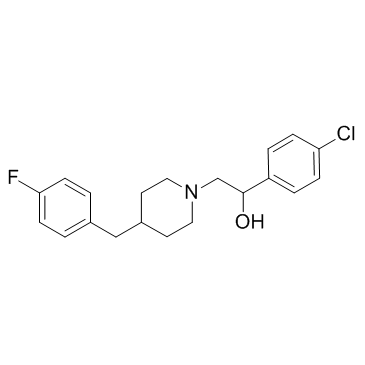Eliprodil

Eliprodil structure
|
Common Name | Eliprodil | ||
|---|---|---|---|---|
| CAS Number | 119431-25-3 | Molecular Weight | 347.85400 | |
| Density | 1.205 g/cm3 | Boiling Point | 474.1ºC at 760 mmHg | |
| Molecular Formula | C20H23ClFNO | Melting Point | N/A | |
| MSDS | Chinese USA | Flash Point | 240.5ºC | |
| Symbol |


GHS07, GHS09 |
Signal Word | Warning | |
|
NMDA receptor antagonists do not block the development of sensitization of catalepsy, but make its expression state-dependent.
Behav. Pharmacol. 12(2) , 143-9, (2001) Dopamine (DA) receptor blockade induces catalepsy in rats which increases in strength upon retesting. This increase in catalepsy represents a form of sensitization which has been shown to be completely context dependent. Sensitization of catalepsy therefore r... |
|
|
Synthesis and resolution of racemic eliprodil and evaluation of the enantiomers of eliprodil as NMDA receptor antagonists.
Bioorg. Med. Chem. Lett. 10(12) , 1377-80, (2000) A short synthesis of the NMDA receptor antagonist (rac)-Eliprodil (9) and its resolution into the enantiomers by chiral HPLC is described. The enantiomers (R)-9 and (S)-9 were found to exhibit markedly different affinities for NR2B subunit containing NMDA rec... |
|
|
The sequential analysis of repeated binary responses: a score test for the case of three time points.
Stat. Med. 25(13) , 2196-214, (2006) In this paper a robust method is developed for the analysis of data consisting of repeated binary observations taken at up to three fixed time points on each subject. The primary objective is to compare outcomes at the last time point, using earlier observati... |
|
|
Human retina contains polyamine sensitive [3H]-ifenprodil binding sites: implications for neuroprotection?
Br. J. Ophthalmol. 83(2) , 236-40, (1999) This study characterised the pharmacology of [3H]-ifenprodil binding to the polyamine binding sites (PBS) on the N-methyl-D-aspartate (NMDA) receptor channel complex on human retinas. These data were correlated with the known neuroprotective effects of ifenpr... |
|
|
Place conditioning of mice with the NMDA receptor antagonists, eliprodil and dizocilpine.
Eur. J. Pharmacol. 362(2-3) , 103-10, (1998) Effects of noncompetitive and competitive NMDA receptor antagonists have been repeatedly characterized using place conditioning models. The present study aimed to characterize the effects in mice of another NMDA receptor antagonist acting at polyamine binding... |
|
|
Neuroprotection afforded by a combination of eliprodil and a thrombolytic agent, rt-PA, in a rat thromboembolic stroke model.
Brain Res. 776(1-2) , 88-95, (1997) In the present study, we have assessed the efficacy of eliprodil, a neuroprotective agent which blocks both the modulatory polyamine site of the NMDA receptor and neuronal voltage-sensitive calcium channels, alone or in combination with the thrombolytic agent... |
|
|
Eliprodil, a non-competitive, NR2B-selective NMDA antagonist, protects pyramidal neurons in hippocampal slices from hypoxic/ischemic damage.
Brain Res. 782(1-2) , 212-8, (1998) The N-methyl-D-aspartate (NMDA) subtype of glutamate receptor is one pathway through which excessive influx of calcium has been suggested to trigger ischemia-induced delayed neuronal death. NMDA receptors are heterooligomeric complexes comprised of both NR1 a... |
|
|
The effect of eliprodil on the evolution of a focal cerebral ischaemia in vivo.
Eur. J. Pharmacol. 352(1) , 29-35, (1998) The purpose of the present study was to evaluate in vivo the effect of a non competitive antagonist of the NMDA receptor, eliprodil, on the size of a focal ischaemic insult and on its temporal evolution in a rat model, using a spin-echo diffusion magnetic res... |
|
|
Decrement in operant performance produced by NMDA receptor antagonists in the rat: tolerance and cross-tolerance.
Pharmacol. Biochem. Behav. 65(4) , 611-20, (2000) Current perspectives on the clinical use of NMDA receptor antagonists infer repeated administration schedules for the management of different pathological states. The development of tolerance and cross-tolerance between different NMDA receptor antagonists may... |
|
|
Adaptation of USP types II and IV controlled release assays for sparingly soluble compounds by direct eluent HPLC analysis.
Pharm. Dev. Technol. 11(1) , 87-91, (2006) Measurement of drug release of a sparingly soluble drug by conventional methods proceeds very slowly without the aid of surfactants. Two preliminary automated methods were developed that increase sensitivity and accelerate such studies by working at very smal... |